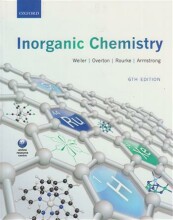Coordinatinon chemistry:reaction of complexes - ligand substitution reactions
22 important questions on Coordinatinon chemistry:reaction of complexes - ligand substitution reactions
Are small metal ions labile or inert?
What are other factors playing a role in ligand substitution?
LIgand substitution constant
- Higher grades + faster learning
- Never study anything twice
- 100% sure, 100% understanding
How does the addition of multiple ligands go, and what does this do with the k value?
ML + L --> ML2 Kf2= [ML2]/[ML][L]
The more ligands are added --> the weaker kf value becomes --> more difficult to attach the ligand
What is known as the chelating effect?
What is the difference of ionic and covalent counting and count both for the following complex: [Fe(3+(CO)3Cll3
Ionic: Fe3+ --> 8-3= 5 + CO=6 + Cl= 6 --> 17 e-
Covalent: Fe--> 8 + CO=6 Cl=3 --> 17e-
What can a higher k value indicate?
What is a cone angle?
What does a increase in cone angle result in?
What is the inner sphere redox reaction?
What is the outer sphere redox reaction?
What is a reduction reaction
2H+ + 2e- --> H2
Opnemen van e-
H+ is the oxidator in a reduction reaction
What is an oxidation reaction?
Zn (s) --> Zn 2+ + 2e-
afstaan van e-
Zn(s) is the reductor in the oxidation reaction
Substrates that can perform oxidative addition to metal centers are non-electrophilic substrates, electrophilic substrates and substrates containing multiple bonds. Explain the non-electrophilic substrates and name examples.
Substrates containing multiple bonds
What metal is the most reactive for oxidative addition?
- Most and strongest donor ligands
- Fewest pi-acceptors ligands
Most negative charge on metal
Reductive elimination, what are the general features?
--> There is more plus charge --> More you will pull the ligand --> favours reductive elimination.
What are the three substitution mechanisms and explain all three.
-Dissociative mechanicsm: Intermediate with lower coordination number, first X leaves, then Y attaches --> X-MLn --> X+ MLn --> X+ MLn-Y (WCO(6)--> W(CO)5+CO --> WCO5(PPH3) (Two step)
-Interchange mechanism: X-ML--> X--MLn--y --> X+ Y-MLn (Occurs for many 6-coordinate species, no detectable intermediate)
Which mechanisms are detectable and which are not?
Not detectable : Associative-associative act , Dissociative dissociative act
What is associative activation?
What is dissociative activation?
How can you know if it is an associative or dissociative mechanism?
Delta V < 0 --> Volume TS < Volume initial state --> Associative
Delta S > 0 --> More disorder --> Dissociative
Delta S< 0 --> less disorder --> Associative
If k1 dominates (straight line) : horizontal --> Dissociative
If k2 dominates --> associative
The question on the page originate from the summary of the following study material:
- A unique study and practice tool
- Never study anything twice again
- Get the grades you hope for
- 100% sure, 100% understanding































